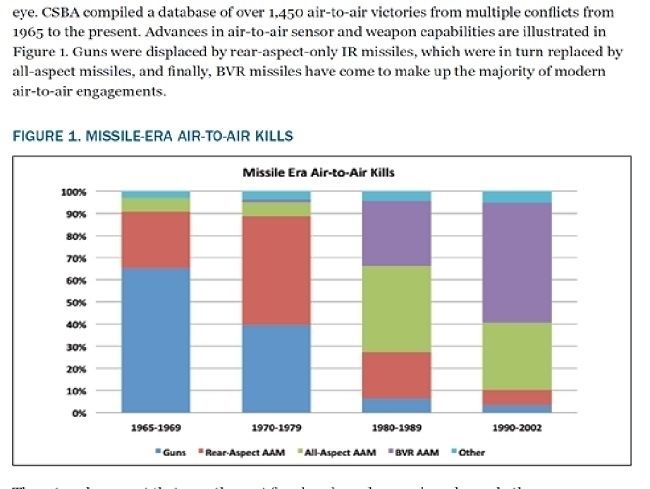shiv wrote:Let us assume that all future air battles will occur at BVR ranges. This is discussed at length in many articles.
The summary is:
For BVR detection you need large radars - so large aircraft. Large aircraft can carry more missiles as well and have the power for all their electronics. This capability is less likely on F-16 sized fighters because of smaller radar size - the latter will need AWACS assistance or they simply cannot manage BVR engagement on their own
This now needs to be applied to LCA and BVR. Small fighter - will need AWACS because radar simply not big enough to detect and engage an BVR range. BVRAAMs make sense in Su-30s, perhaps even MiG 29. But LCA - I am quoting articles that are gung ho about BVR.
That summary, is to put it mildly, completely wrong thanks to being pulled from the likes of Das, who don't have the first clue about modern systems. I suspect if you had done your own reading rather than relying on his initial direction, you would have come to a far more informed assessment.
Saab Gripen. "Light fighter". Meteor, the most formidable long range all-up BVR missile in service today. Not merely targeted at bombers etc.
http://www.defensenews.com/story/defens ... /26692269/
"The addition of Meteor air-to-air capability makes Gripen the most formidable counter-air platform in service," Ahlqvist declared. The missile will become operational with Swedish Air Force Gripens in 2016.
And while a new active electronically scanned array (AESA) radar is being fielded with the E/F aircraft, Saab Defense Systems has developed a new Mark 4 version of its PS-05/A radar for the Cs and Ds.
The Mark 4 radar — discussed by Saab for the first time on April 27 — essentially doubles air-to-air and air-to-ground detection ranges, Ahlqvist said, and has improved abilities to detect very low-radar cross-section targets.
The system, he added, "offers significant functional growth through software upgrades, and offers full [advanced, medium-range, air-to-air missile] and Meteor missile integration." Impact on aircraft upgrading from Mark 3 radars to Mark 4 is "very small, an absolute minimum. You can easily switch between Mark 3 and Mark 4 configuration."
LCA, light fighter.
http://aviationweek.com/paris-air-show- ... formance-0
RAFAEL is unveiling a new, extended range version of its Beyond Visual Range (BVR) active radar-guided air-to-air missile – the I-Derby ER.
The new seeker is lighter and more compact than its predecessor, thus clearing valuable space which has been used by the missile designers to increase the propulsion system by adding a second mode (kick), accelerating the missile at the terminal phase of the flight. This new addition increases the range of the I-Derby ER beyond 100 km., significantly more than its current “short/medium” range capability.
This “second kick” greatly improves the missile’s performance. “This phase is not serial, but operates independently of the primary rocket propulsion as it is activated at any time during the fight, by the flight control system.” Yaniv explains. The second pulse would likely kick in when the missile is closing on its target, accelerating it and increasing its kinematic envelope, thus increasing its “no escape zone”.
....
RAFAEL claims it will be able to deliver 80% of the Meteor’s performance at a third of its cost. It is also superior to the AIM-120C7 and more affordable, the company claims. Already cleared on F-16 (Block 52), F-5E, Kfir and Sea Harrier, I-Derby ER integration tests are currently under way on the Indian Tejas LCA.
This capability is less likely on F-16 sized fighters because of smaller radar size - the latter will need AWACS assistance or they simply cannot manage BVR engagement on their own
AN/APG-80 on the F-16 Block 60. AW&ST, 70-80nm against a 1sq mtr target.
I suspect most AF would take that performance hand over foot if they could get it.
Long story short, state of the art systems even on "small fighters" can be very potent.
Physical dimensions especially on the LCA are not anything to sneeze at.
It can fit in a radome the size of what is on the MiG-29. Aperture area matters for received power. If a state of the art AESA is put in, with high gain & reliability & the electrical systems from a Ge404 are adjusted to deliver the power (and no reason why they can't be to a decent extent), we are looking at credible performance.
Look at the topic a bit more please, before jumping to misleading conclusions.
The issue is basically one of who has the best tech. The US leads in compact packaging of TRMs, hence even their smallest radars can be very powerful and capable. The Israelis and Euros are also not very far behind. The Russians are catching up. In terms of software, experience all these nations have very credible backgrounds. India is catching up in GBAD. We have a ways to go in A2A systems but we will get there (if we show consistency).
One does not even need to always be active on radar for being adept at BVR. See:
http://www.livefistdefence.com/2009/07/ ... -test.html
While the first live firing of the Derby active-radar seeker missile was conducted using the aircraft's primary sensor, the next test will be from one of the Navy's upgraded Sea Harriers with its radar switched off. Guidance will be provided from another platform, either on the ground or in the air.
Which is pretty similar to what was talked about for platforms like the Gripen and F-22.





